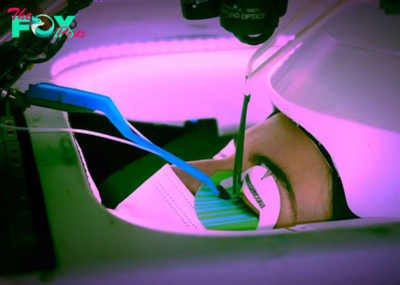Technology
Uncertainty Is Uncomfortable, and Technology Makes It Worse. That Doesn’t Have to Be a Bad Thing
On July 19, 2024, a single-digit error in the software update of cybersecurity company CrowdStrike grounded international airlines, halted emergency medical treatments, and paralyzed global commerce. The expansive network that had enabled CrowdStrike to access information from over a trillion events every day and prevent more than 75,000 security breaches every year, had ironically introduced a new form of uncertainty of colossal significance. The impact of a seemingly minor error in the code was now at risk of being exponentially magnified by the network, unleashing the kind of global havoc we witnessed last July.
The very mechanism that had reduced the uncertainty of regular cyber threats had concurrently increased the unpredictability of a rare global catastrophe—and with it, the deepening cracks in our relationship with uncertainty and technology.
Our deep-seated discomfort with uncertainty—a discomfort rooted not in just in technology but in our very biology—was vividly demonstrated in a 2017 experiment where London-based researchers gave consenting volunteers painful electric shocks to the hand while measuring physiological markers of distress. Knowing there was only 50-50 chance of receiving the shock agitated the volunteers far more than knowing the painful shock was imminent, highlighting how much more unsettling uncertainty can be compared to the certainty of discomfort.
This drive to eliminate uncertainty has long been a catalyst for technological progress and turned the wheels of innovation. From using fire to dispel the fear of darkness to mechanizing agriculture to guarantee food abundance, humanity’s innovations have consistently aimed to turn uncertainty into something controllable and predictable on a global scale.
Read More: Here’s Why Uncertainty Makes You So Miserable
But much like energy, uncertainty can be transformed but never destroyed. When we think we have removed it, we have merely shifted it to a different plane. This gives rise to the possibility of an intriguing paradox: With each technological advancement designed to reduce uncertainty, do we inadvertently introduce new uncertainties, making the world even more unpredictable?
Automated algorithms have revolutionized financial trading at an astronomical scale by shattering human limits on speed, precision and accuracy. Yet, in the process of eliminating human error and decoding complex probabilities in foreign exchange trading, these systems have introduced new uncertainties of their own—uncertainties too intricate for human comprehension. What once plagued day-to-day trading with human-scale uncertainty has morphed into technology-scale risks that didn’t exist before. By lowering some forms of uncertainty, these automated algorithms have ultimately increased it.
A striking example of this is algorithmic trading, where software is used to eradicate uncertainty and upgrade financial systems. It is, however, impossible to test sophisticated permutation of every pathway in a software decision tree, meaning that even the most sophisticated upgrades inevitably introduce new uncertainties. Subtle errors, camouflaged in labyrinthine webs of code, become imperceptible at the lightning speed of execution. In August 2012, when the NYSE’s Retail Liquidity Program went live, global financial services firm Knight Capital was equipped with a high-frequency trading algorithm. Unfortunately, an overnight glitch in the code amplified the error to a disastrous degree, costing Knight Capital $440 million in just 30 minutes.
As technology becomes more sophisticated, it not only eradicates the uncertainty of time and distance from our everyday lives but also transforms how we experience uncertainty itself. An app informs you exactly when the bus you are waiting for will arrive, a check mark tells you when your friend has not only received but read your message, and a ding lets you know someone is waiting on your doorstep when you are on vacation on a different continent. This information is often incredibly useful. Yet, the same technology floods us with unsolicited, irrelevant details. Worse, it often captures our attention by delivering fragments of incomplete information: a partial news headline pops up on our phone, an alert from our home security system reports unusual activity on our property, a new friend request slides into our social media inbox. Resolving these uncertainties requires us to swipe, click, or watch, only to be bombarded with yet another stream of incomplete information. Instead of resolving uncertainty, the information often leaves us with more of it.
Rarely do we stop to ask ourselves if the kinds of frequent, small-scale uncertainties that modern Technology is designed to eliminate are really so terrible in the first place. If we did, we might realize that human-scale uncertainties make us more resilient, revealing weaknesses we did not know we had.
Historical evidence suggests that eliminating uncertainty isn’t always beneficial. Angkor, the medieval capital of the ancient Khmer empire, became the largest pre-industrial city in the world partly because its population was able to tame the uncertainty of nature through creating an elaborate water management network. This system eliminated the unpredictability of monsoon rains, sustaining Angkor’s agrarian population, which grew to nearly a million. Yet this very system may also have contributed to the city’s collapse. When Angkor was struck by severe droughts and violent monsoons in the 14th and 15th centuries, their reliance on guaranteed water supplies left its people vulnerable to disaster.
The uncertainty paradox does not stem from innovation in itself. Innovating solutions for large scale uncertainties has manifestly saved countless lives. Modern day examples include Sanitation Technology that has helped to eradicate cholera in many parts of the world and Tuned Mass Damper (TMD) Technology that protected the Taipei 101 skyscraper during a 7.4 magnitude earthquake in 2024. Instead, the uncertainty paradox seems to emerge when we seek to erase smaller scale, everyday uncertainties entirely from our lives. This can make us more vulnerable, as we forget how to deal with unexpected uncertainty when it finally strikes. One solution is to deliberately create opportunities to experience and rehearse dealing with uncertainty. Hong Kong’s resilience in the face of intense typhoons stems from regular exposure to monsoon rains—preparing the city to withstand storms that could devastate other parts of the world.
Netflix engineers Yury Izrailevsky and Ariel Tseitlin captured this idea in their creation of “Chaos Monkey,” a tool that deliberately introduces system failures so engineers can identify weaknesses and build better recovery mechanisms. Inspired by this concept, many organizations now conduct “uncertainty drills” to prepare for unexpected challenges. However, while drills prepare us for the known scenarios, true resilience requires training our reactions to uncertainty itself—not just our responses to specific situations. Athletes and Navy SEALS incorporate deliberate worst-case scenarios in their training to build mental fortitude and adaptability in the face of the unknown.
The relationship between uncertainty and technology is like an Ouroboros: we create technology to eliminate uncertainty, yet that technology generates new uncertainties that we must eliminate all over again. Rather than trying to break this cycle, the solution may be paradoxical: to make the world feel more certain, we might need to embrace a little more uncertainty every day.
-

 Technology52m ago
Technology52m agoAwkwardness can hit in any social situation – here are a philosopher’s 5 strategies to navigate it with grace
-

 Technology52m ago
Technology52m agoNo need to overload your cranberry sauce with sugar this holiday season − a food scientist explains how to cook with fewer added sweeteners
-

 Technology7h ago
Technology7h agoTeslas are deadliest road vehicles despite safety features: study | The Express Tribune
-

 Technology23h ago
Technology23h agoUS pushes to break up Google, calls for Chrome sell-off in major antitrust move | The Express Tribune
-

 Technology1d ago
Technology1d agoPublic health surveillance, from social media to sewage, spots disease outbreaks early to stop them fast
-

 Technology1d ago
Technology1d agoTikTok, PTA host youth safety summit in Pakistan | The Express Tribune
-

 Technology1d ago
Technology1d agoTransplanting insulin-making cells to treat Type 1 diabetes is challenging − but stem cells offer a potential improvement
-

 Technology1d ago
Technology1d agoJapan's $26 billion deep sea discovery sparks serious environmental concerns | The Express Tribune



























